
Hearts of Iron IV Review
American general William Tecumseh Sherman once said that “war is hell” and that its glory “is all moonshine”. Sherman, however, never single-handedly turned France into a communist paradise and then won the Second World War by 1941. Well I did in Hearts of Iron IV and I can tell you that it’s pretty bloody glorious.
A sequel to the hard-as-nails Hearts of Iron III, this new instalment has seen developers Paradox Interactive go all-out to try and make an accessible successor that still retains the series’ lauded depth and detail. The masters of grand strategy have certainly made large strides towards that goal, but does it pass muster?
Hearts of Iron IV places you in control of a nation during the build-up to the greatest conflict mankind has ever seen. At release there are two scenarios available - 1936 and 1939. The latter drops you right into the thick of it at the outbreak of war while the former allows you to prepare your chosen nation for a number of years in advance. There are seven major factions: America, Japan, Great Britain, France, Italy, Russia and Germany, each with their own special traits, bonuses and penalties. Players who like to root for the underdog will be pleased to know that Paradox have lifted the restriction on what minor nation you can play as. From Liberia and Albania to Brazil and Portugal - every nation on Earth is playable (though whether they’ll survive long is another matter altogether).
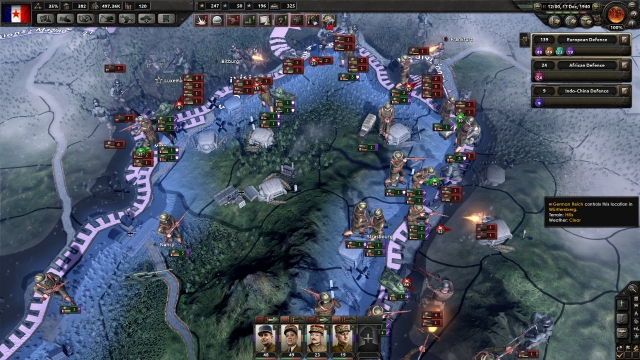
The running of your nation is done by your representative political party, which can be moderated by governmental decrees. Your choice of political representative is by no means static - put the right policies into place and you can overthrow it with a stance of your choice. I’ve played as a communist France and a fascist Great Britain and even almost managed to create a democratic Germany (thus negating the entire war). What surprised me is that each of these eventualities has its own tailor-made notifications, events and consequences. I’ve gone through multiple campaigns turning countries into communist or fascist states just to see their flags change (pro tip: check out the badass communist America flag when you can). To further these crazy ambitions, Paradox allows the player to uncheck a ‘historical reality’ box on start-up that lifts the restrictions on the AI as to what decisions it makes, giving it free reign to create a true sandbox of ‘what if?’ questions.
To further your nation’s goals a number of initiatives can be undertaken through research and development, as well as a new feature named ‘National Focus’. Similar to a skill tree, National Focus lines are a way to quickly develop your nation and take on policies. You can’t choose them all, though, and some parts of the tree are mutually exclusive. All the major factions have a bespoke tree and some minor ones have unique options too, such as Poland, Finland, China and Spain.
There is no real currency in play in Hearts of Iron IV. Instead there are a number of resources that are needed to produce units, supply your forces and ensure that trade is maintained. These come in the shape of civilian factories, military factories, naval dockyards and manpower. The first three can be built upon as you go, the latter is affected by population figures, national unity and your type of government. Without manpower your front-line units will dwindle and be poorly reinforced, too, so it’s a figure that always needs watching. Your industry and production can all be bumped up by research and government policy, meaning that a careful balance can even redress some factions deficiencies at the start of play.
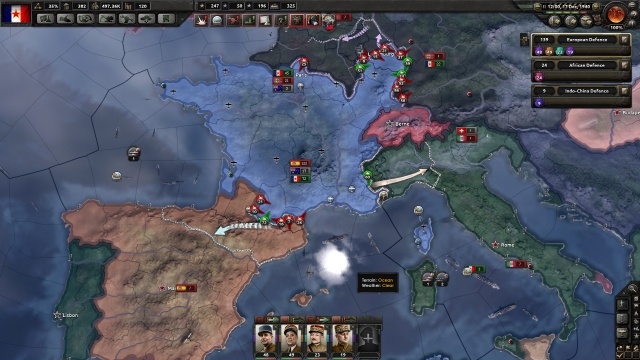
The campaign map is split into three main views, each assigned to one of the three wings of your armed forces: army, navy and air force. While the army view splits the map into real-life provinces, regions and countries, the latter two create sweeping zones of coverage to better manage wide-scale operations. It’s a welcome change, as co-ordinating your three forces was a challenging task in the game’s predecessor. Navies and air wings can be moved between air bases and docks and then assigned to zones in turn. Once they’re assigned you can then give them a type of mission to undertake, like interception or convoy raiding. A small marker will indicate how successful these missions are via a percentage readout.
Veterans of Hearts of Iron III will know that a poor start in 1936 in that game would lose you the entire campaign - you just wouldn’t know it until war started in 1939. It took me a good hour or so of Wikipedia-reading to fully understand how armies, industry and infrastructure worked, as well as how to properly set up my supply lines. A lot of this has been trimmed down by Paradox for the sequel and while some stalwarts of the series might prefer the hierarchical army system from the third installment, it’s now FAR easier to organise armies and get them moving to where you need them to act.
The game really breaks down into two main stages: the build up from 1936 to 1939 and the crescendo when war is finally declared on (or by) your nation. The former is fast-paced and lively as you go through organising and renaming fleets and armies, building infrastructure and waiting for research and National Focus timers to drop. It’s a flurry of activity that is blistering compared to when you’re deep into the war. Once it’s in full swing it becomes a matter of days, not years. Tactics are tweaked, units maneuvered and enemy movement watched with a hawkish eye. I finished my France campaign by 1941 yet felt mentally exhausted at having to control three separate fronts at once (in Italy, Germany and Spain). That exhaustion was by no means unwelcome, it was accompanied by an exhilaration that I had come out on top against a cunning AI that had tried to exploit my every weakness.
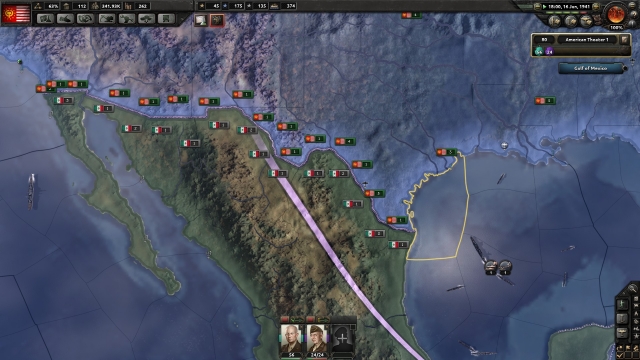
At each war’s conclusion (for there can be many, not just one global conflict), your nation is invited to a peace conference where it can make demands based on its contribution. It’s a great touch to proceedings and is a fantastic way to bookend a successful campaign. There were some cases in which this didn’t trigger, leaving me to spend years waiting for pockets of resistance to be mopped up and wonder “what now”?. Hopefully that particular bug will be sorted by release.
Trade and diplomacy has also been given the slimming treatment. In older iterations in the series the multitude of screens could become confusing and a little overwhelming to the newcomer, now the process has been simplified to exchanging your civilian factories’ capacity for resources. It makes gathering resources when you’re time-short a lot easier. Diplomacy, however, still feels slightly tacked-on and light on features. Gone are the spies and espionage of Hearts of Iron III, replaced by a list of options that are ruled by their opinion of you and your political power (another resource, accumulated by your government). For much of the game it was I who reached out to other factions for trade and negotiations, I barely received any notices from the AI until war broke out. In some ways this may be a blessing in disguise, as being bombarded by trade messages in Hearts of Iron III was something I personally found highly frustrating.
Army management has become a far more streamlined process. Groups of units can be selected and then assigned a commander - either a general who can control 24 divisions or a field marshall who can control 72 or more. Once assigned, orders can be made to the commander who will carry them out to the best of his ability. Players no longer have to issue unit-by-unit commands, though the option is still available if needed. Orders to your commander take the shape of visualised front-lines on the world map, with attractively-drawn advance and fallback indicators and helpful highlights of just where your troops will attack. Grand strategy is now something far more doable in Hearts of Iron, and drawing countless arrows for flanking maneuvers and lightening strikes makes you feel far more connected to what your troops are doing.
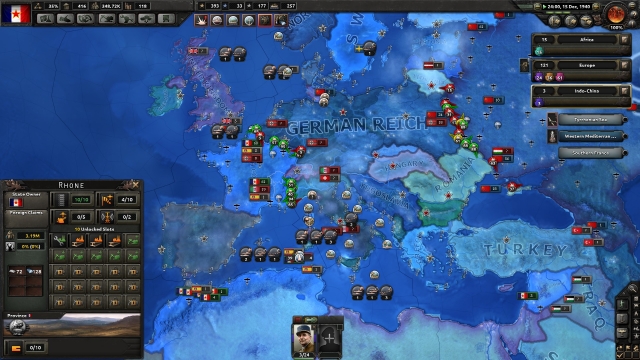
When battle is joined on land, a small indicator will appear between two forces, a ticking number in the centre showing how close the clash is to its finish. If it’s green you're winning and if it's red you're losing. Clicking on the indicator brings up a more detailed panel showing you the tactics your generals are employing, what units are involved and what factors and terrain features are dictating their combat effectiveness. Combat in the air is measured in percentages too, but on the existing ‘mission efficiency’ icons. Naval battle occurs in a similar way, though their engagements are often short and sharp, and can sometimes come and go before you notice.
Visually, Hearts of Iron IV comes with the quintessential Paradox grand strategy feel - one of a living Risk board at your fingertips. The world in which you play is lit up in appealing colours and hues which switch pleasingly when filters are changed. The names of countries above their landmass hover like titanic credits scrolling across the globe, while rain, blizzards and storms flash and burst out in myriad provinces and ocean zones. Divisions (when zoomed in) are represented by soldiers standing at attention, tanks with engines humming along or cavalrymen sat restlessly atop their mounts. These 3D models can be switched off so that the units are simply reflected by their markers, but unlike Hearts of Iron III these can be hard to spot properly on the map.
The game’s musical scores wouldn’t be out of place on some HBO epic about the Second World War - it’s all rising string crescendos and sweeping orchestral movements designed to swell the heart. They certainly go some way to preparing the player for the upcoming conflict. The game is equipped with an effective, if not outstanding, array of sounds for each of the units, as well as era-specific touches on events like telegrams and communiques.
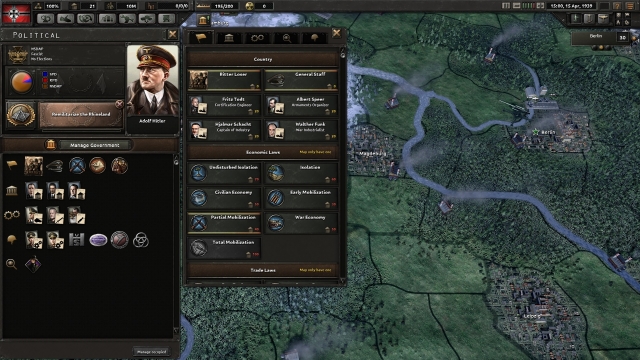
Hearts of Iron IV is furnished with a feature-rich multiplayer experience that doesn’t remove any of the main game’s mechanics to simplify things. Despite this, when a number of players are involved it could become a slightly confusing playthrough - Hearts of Iron usually has a larger number of moving parts than Paradox’s other series like Crusader Kings. I tested the multiplayer out against my (admittedly reluctant) flatmate, and can confirm it feels just as good to completely obliterate your friends as it does the AI.
Hearts of Iron IV is a fantastic entry into what is already acknowledged as one of the best Second World War strategy series in gaming. Mixing just the right amount of detail, depth and accessibility, the developers have crafted a formula that will please returning veterans and allow new players to enter the series without having to read an encyclopaedia of rules and stratagems first. Sandbox possibilities and endless ‘what-if’ questions only bump up what is already an impressive level of replayability. Paradox Interactive have created a game that strategy gamers and history buffs should get on their shelves as soon as possible.
Hearts of Iron IV (Reviewed on Windows)
Excellent. Look out for this one.
Sandbox possibilities and endless ‘what-if’ questions bump up what is already an impressive level of replayability. Paradox Interactive have created a game that strategy gamers and history buffs should get on their shelves as soon as possible.




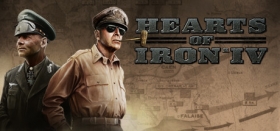






COMMENTS
pucechan - 10:07am, 7th June 2016
Definitely on the 'must-buy soon' list after reading this. Paradox continuously knock it out the park lately!